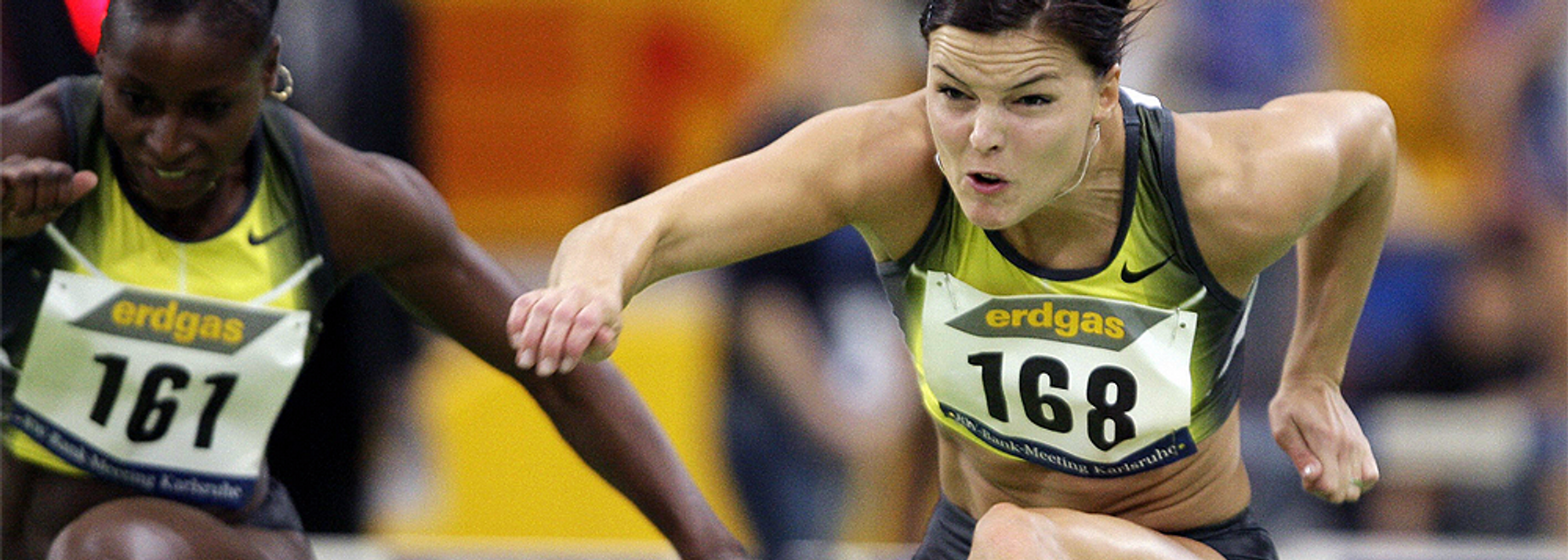Susanna Kallur on her way to a world 60m hurdles record at the BW-Bank Meeting in Karlsruhe in 2008 (© AFP / Getty Images)
When she casts her mind back to the evening of 10 February 2008, Susanna Kallur is not entirely satisfied with her 60m hurdles performance at the BW-Bank Meeting in Karlsruhe. “I still think my start could have been a little bit better,” she concedes.
At the time, 15 years ago now, the Swede was at the top of her high hurdles game. “I felt unstoppable,” Kallur reflects. “The feeling then was just magic. It felt like my body just ran by itself.”
That night in south-west Germany, despite her less than fully perfect start, Kallur flew over the five barriers in her path to a world indoor record for the 60m hurdles: 7.68.
The previous mark, 7.69, had stood since 1990 to Lyudmila Narozhilenko, as the Soviet-born hurdler was known before she transferred allegiance to Sweden (as Lyudmila Engquist) and her career became tarnished with a drugs ban.
As Ed Gordon noted in his meeting report for the World Athletics website: “Of the recognised international championship discipline track event records, only the women’s 400m world indoor record of Jarmila Kratochvilova from 1982 is older.”
Kratochvilova’s 49.59 remains intact, 41 years after it was set in Athens. Kallur’s figures have survived for a decade and a half now. Only Sharika Nelvis and Kendra Harrison have come close, the US duo both clocking 7.70 in 2018.

Susanna Kallur in action in the heats of the women's 100m hurdles at the 2008 Olympics (© Getty Images)
At the time, in Karlsruhe in 2006, the US-born Kallur was happy with her performance. Her start was better than the sluggish one that cost her the record in Stuttgart eight days previously, when she finished fast in 7.72. She led at the first flight and, as Gordon reported: “Her computer-perfect form clicked off the remaining four hurdles faster than anyone has before.”
Lolo Jones, the latest talent to emerge from the deep well of world-class US women’s high hurdlers, finished second in 7.77. That moved the native Iowan to second on the US all-time list, behind Gail Devers’ 7.74.
“This is absolutely unbelievable,” Kallur told the trackside interviewer in the Europahalle Arena. “I can’t put my feelings into words. In comparison with my start last week in Stuttgart, today was much better.
“It may not have been perfect tonight but no-one in history has run faster.”
In the immediate aftermath, it was suggested to Kallur that she should consider herself favourite for the 100m hurdles at that year’s Olympic Games in Beijing. Despite her inner feeling of invincibility, the Swede remained grounded in public.
“I’m just focusing on the 60m hurdles right now,” she insisted. “I entered the season with a goal of running a PB and winning the world indoor title in Valencia. I’m not looking beyond that.”
Six days shy of her 26th birthday, the younger of the Kallur twins was at the peak of her track powers.
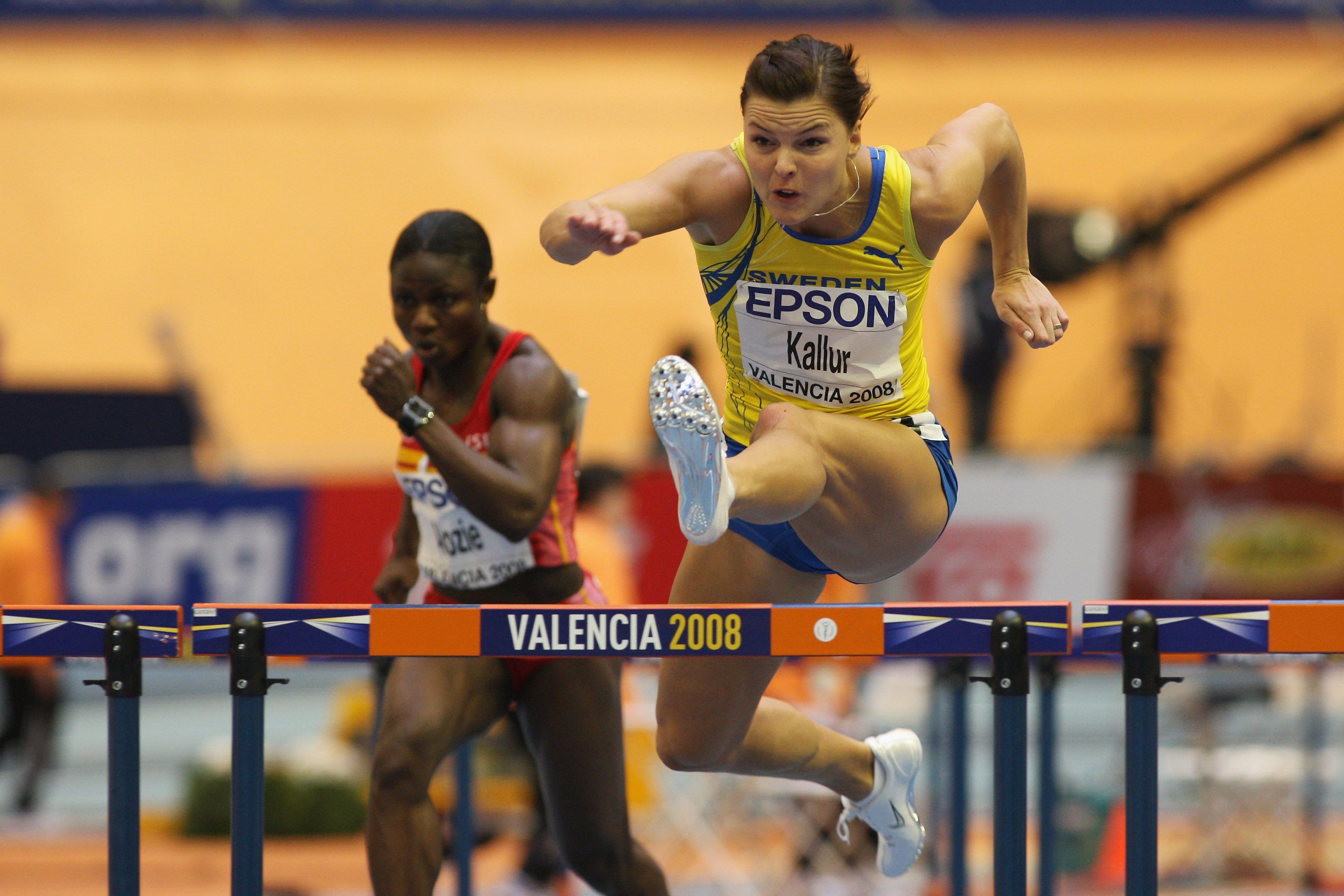
Susanna Kallur competes at the World Indoor Championships in Valencia (© Getty Images)
Chilean gold
Susanna was born four minutes after her sister Jenny on 16 February 1981 at Huntington on Long Island, New York State - also the birthplace of such luminaries as piano man Billy Joel, poet Walt Whitman, writer Jack Kerouac, aviator Charles Lindbergh, Seinfeld star Jason Alexander and Edie Falco of The Sopranos.
The Kallurs were born New Yorkers because their father, Anders, played for the New York Islanders ice hockey club from 1979 to 1985. A Swedish legend in the sport, he won four Stanley Cups with the Islanders.
The Kallurs moved back to Sweden in 1986 and Susanna and Jenny started their sporting careers as gymnasts, making the national junior squad, before switching to track and field.
Members of the Falu IK club in Falun, 140 miles north-west of Stockholm, they were both selected for the 100m hurdles at the World U20 Championships in Santiago in 2000. Susanna was a class apart in the final, winning by 0.19 in 13.02. Jenny finished sixth in 13.30.
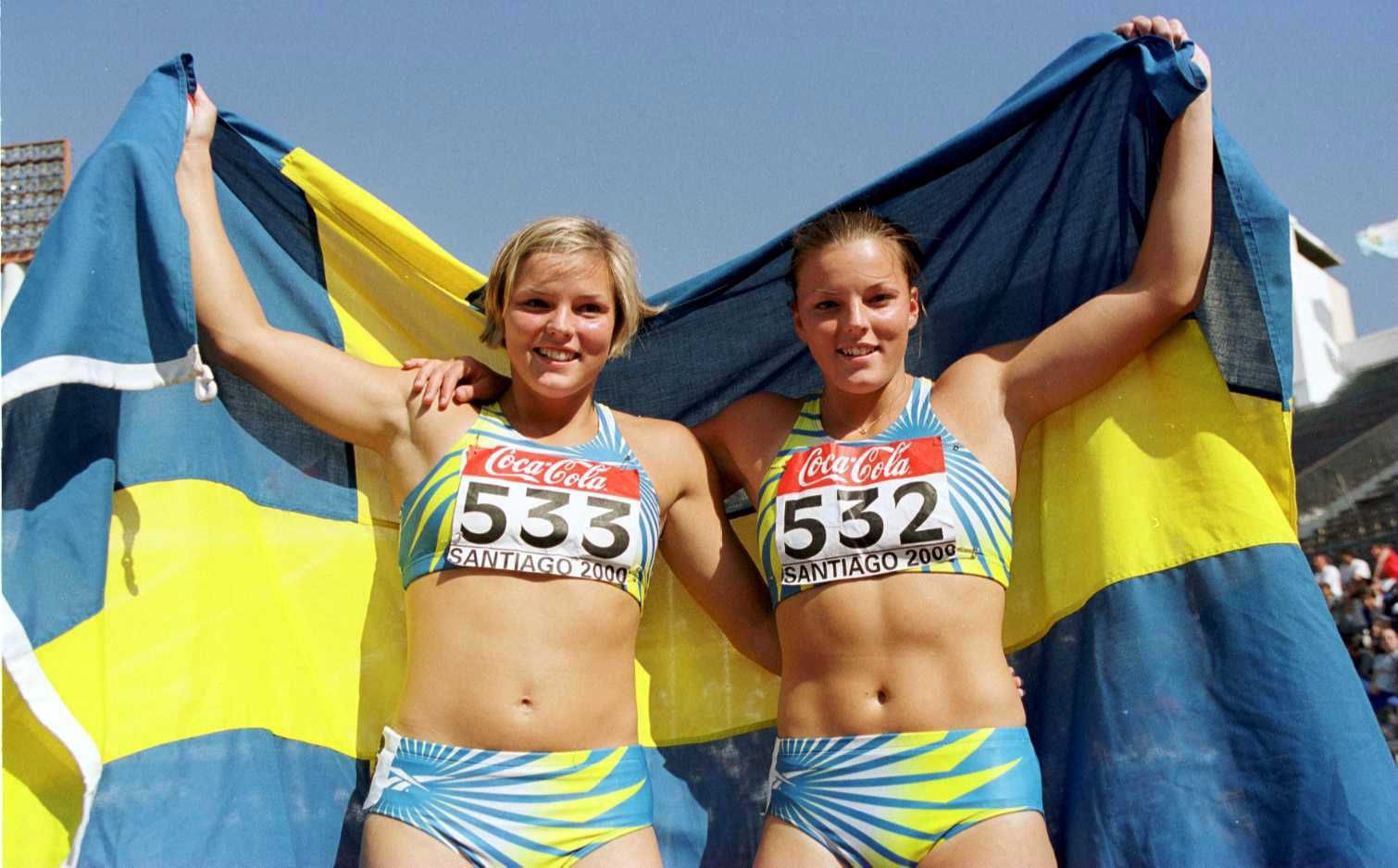
The 2000 world U20 100m hurdles winner Susanna Kallur (533) celebrates with her twin sister Jenny in Santiago (© Getty Images)
Unlike fellow Swedish golden girl Carolina Kluft, winner of the heptathlon title in the Chilean capital, it took Susanna time to make her mark as a senior athlete.
Kluft graduated to world senior champion in Paris in 2003 and was one of three Swedish gold medal winners at the Olympic Games in Athens a year later, together with high jumper Stefan Holm and triple jumper Christian Olsson.
Susanna failed to make it beyond the semifinals in Paris or Athens but claimed her first senior international medal at the 2005 European Indoor Championships in Madrid: gold in the 60m hurdles, with Jenny taking silver in her slipstream.
Beating the ‘Tre Kronor’
Then came world indoor bronze in Moscow in early 2006, followed by European outdoor gold on home ground at the Ullevi Stadium in Gothenburg.
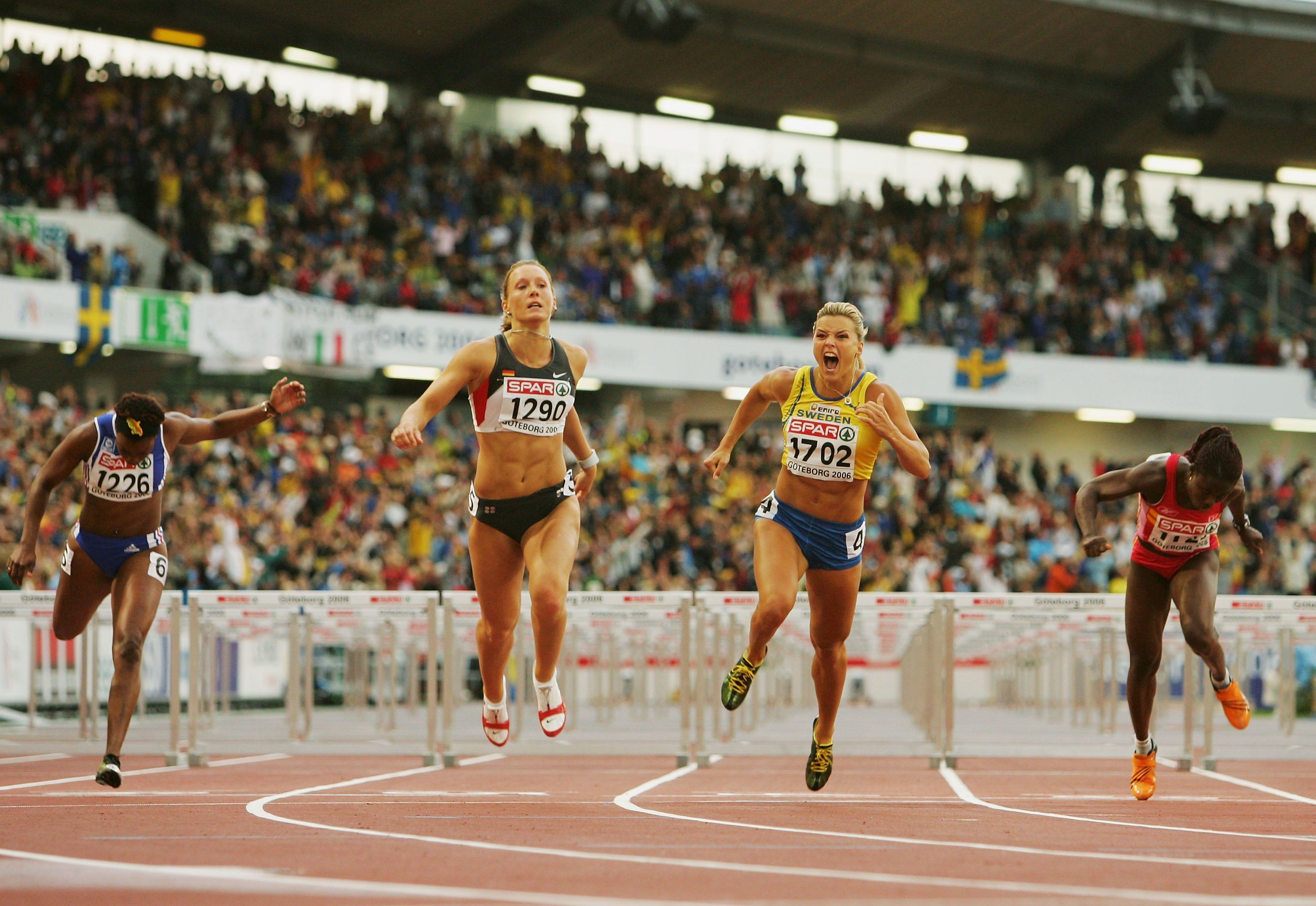
Susanna Kallur celebrates her European 100m hurdles win in Gothenburg in 2006 (© Getty Images)
In January 2007, 'Sanna' – as she was known to the adoring public in her homeland – was named Swedish sports personality of 2006, trumping Kluft and the Swedish men’s ice hockey team, whose unprecedented Olympic and World Championship successes sparked national parades. She was presented with the coveted Jerringspriset trophy by King Carl VXI Gustav.
"I never thought I would beat the Tre Kronor," Susanna said, referring to the nickname of the national ice hockey team, ‘the three crowns.’ "It beats everything: to take the prize that the Swedish people have voted for. Last year was a dream for me, winning a gold medal in my own country, but I have to take things forward now.”
Two months later, Queen Sanna retained her European indoor crown in Birmingham.
The seemingly unstoppable is stopped
During the 2007 outdoor season she reduced her lifetime 100m hurdles best to 12.49 but suffered heartache at the World Athletics Championships in Osaka, finishing fourth in the final – missing a medal by 0.01 – after leading until the eighth hurdle.
Eventual winner Michelle Perry of the US drifted into Kallur’s lane but the Swedish management chose not to appeal as there was no photographic evidence available within the allowable protest period.
Then came the 2008 indoor season and the run of form that took her to national records of 7.80, 7.75 and 7.72 before the 6.68 world indoor record in Karlsruhe. World indoor gold in Valencia beckoned – and the real possibility of Olympic gold in Beijing five months beyond.
Sadly, the seemingly unstoppable force was confronted by the immovable hand of fate. Kallur was the fastest heat winner in Valencia but suffered a hamstring injury warming up for her semifinal. Jones won the final in 7.80.
The world indoor record-holder made it back for the Olympics but crashed out at the first hurdle in her semifinal. Due to a succession of injuries, and the birth of her daughter Majken in 2013, she was absent from the international scene for eight years.
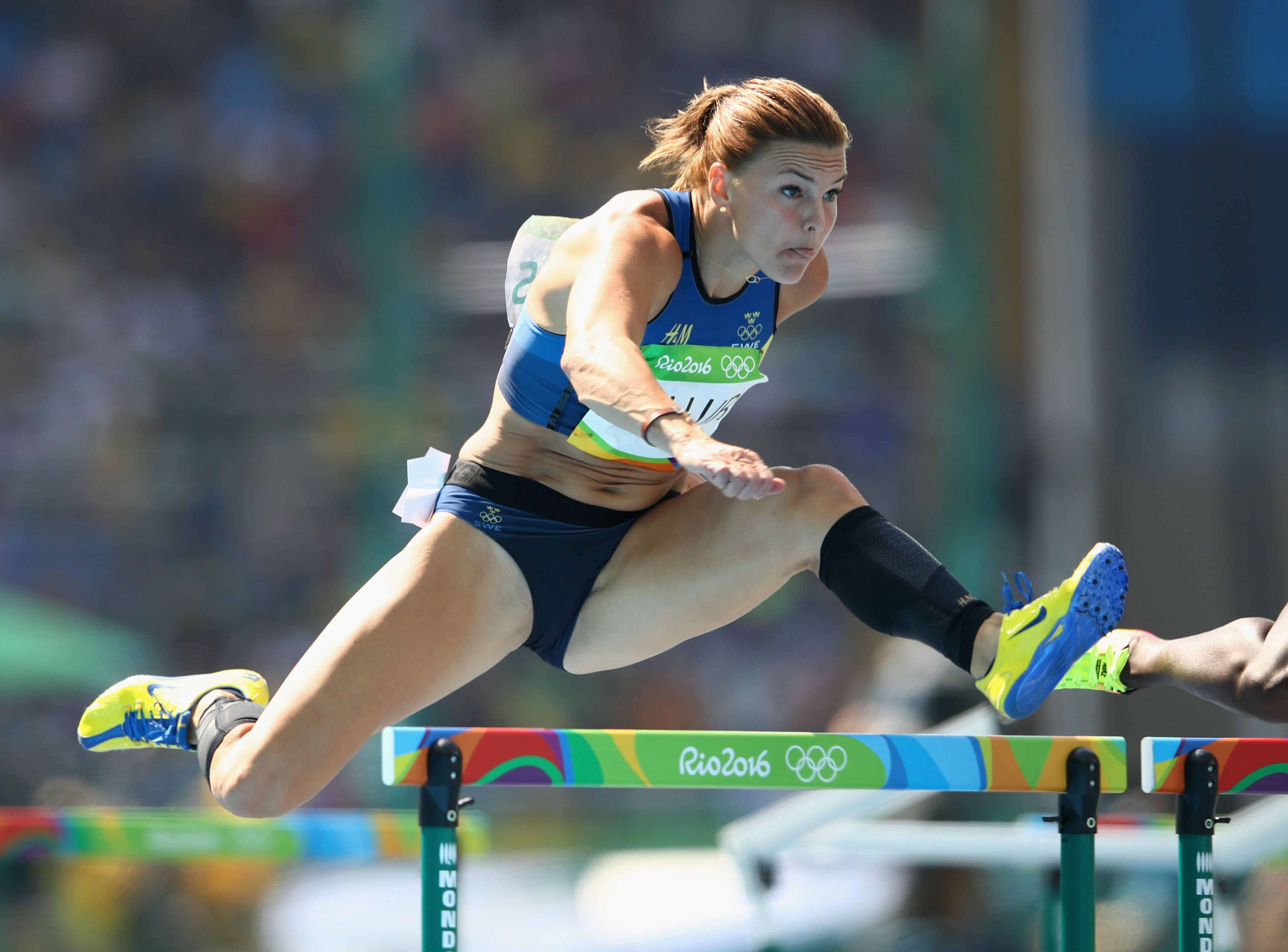
Susanna Kallur competes at the 2016 Olympics in Rio (© Getty Images)
In the 2016 outdoor season, Kallur made the semifinals at the European Championships in Amsterdam and ran in the heats at the Olympic Games in Rio, but she bowed out gracefully in March the following year - after finishing eighth in the 60m hurdles final at the European Indoor Championships in Belgrade.
“I can’t train for the hurdles properly now,” Kallur lamented. “I’m not able to perform as well as I want to.
“I’ve kept going all of these years because the injuries came right after my world indoor record. At that time, I felt like I was just starting out at that level. I wanted to have a few more seasons, to compete for Olympic and World Championships medals.
“I felt like I was unstoppable in 2008. Now, I can see that I was stoppable.”
Simon Turnbull for World Athletics Heritage


